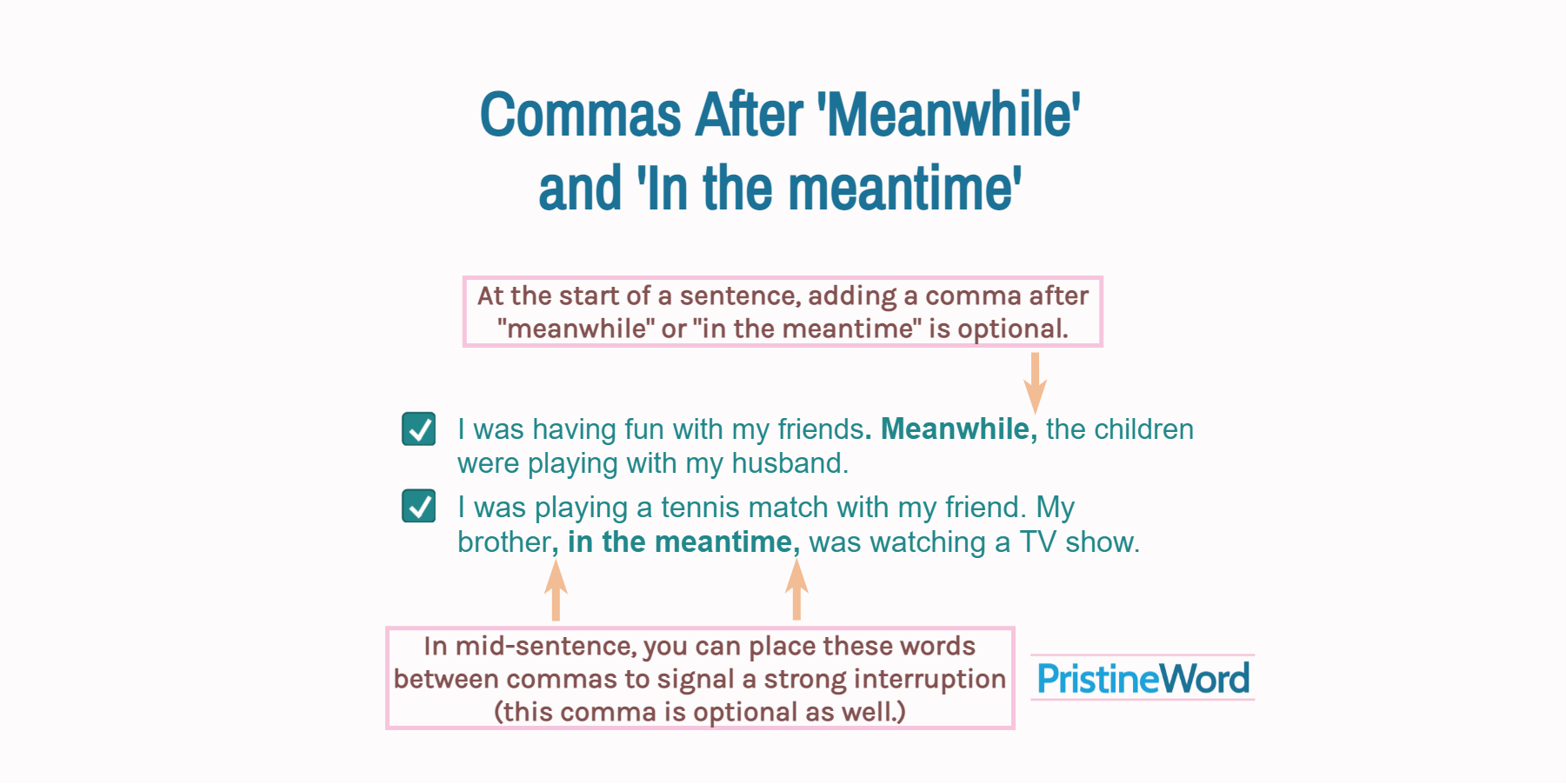At the start of a sentence, using a comma after "meanwhile" or "in the meantime" is optional. Commas are also optional in mid-sentence, but we should use them to signal a strong interruption or include nonessential information.
At the start of a sentence, using a comma after "meanwhile" or "in the meantime" is optional.
I was having fun with my friends. Meanwhile, the children were playing with my husband.
Commas are also optional in mid-sentence, but we should use them to signal a strong interruption or include nonessential information.
I was playing a tennis match with my friend. My brother, in the meantime, was watching a TV show.
Contents
1. 'Meanwhile' vs. 'In the meantime'
"In the meantime" is typically used to refer to a period between two times or events.
I had to wait for 30 minutes. In the meantime I checked my email.
"Meanwhile" has two meanings:
- Period between two events. Thus, "meanwhile" and "in the meantime" have the same meaning and can be used in the same way.
- At the same time. We can use "meanwhile" to express that two actions or events are happening at the same time. In this sense, the subordinating conjunction while has a similar meaning, but the sentence structure is different.
2. How to Punctuate 'In the meantime' in a Sentence
"In the meantime" is a prepositional phrase that can be used at the start or in the middle of a sentence. As a general rule, we should use a comma after propositional phrases of five or more words.
Since "in the meantime" contains only three words, the comma is optional.
My wife was working. In the meantime I didn't have anything to do, so I read a book.
But you can add a comma to signal a pause or avoid confusion.
Our son was watching a movie. In the meantime, we were having dinner at a Japanese restaurant.
When using "in the meantime" to introduce a longer prepositional phrase (more than three or four words), add a comma after the phrase.
In the meantime between flights, I bought a shirt and a new book.
In the meantime between flights I bought a shirt and a new book.
We do not frequently use commas when using "in the meantime" in mid-sentence.
I'll pack some food, and in the meantime you can call for a taxi.
But use a comma before and after "in the meantime" to signal a strong interruption.
The doctor will be here soon, and, in the meantime, try to relax by placing your hand on your stomach while taking slow, deep breaths.
Follow the same comma rules with the expression "for the time being" to express "as this time".
3. Commas Before and After 'Meanwhile'
Conjunctive adverbs are generally followed by a comma at the start of a sentence. But there are exceptions. For example, you can skip the commas with single-word adverbs of time, such as "meanwhile".
John was playing video games. Meanwhile his wife was watching TV.
Sometimes, though, we use a comma to make clearer that "meanwhile" modifies the complete sentence or clause that follows.
The economic situation is getting worse. Meanwhile, the company is handling this matter privately and securely.
My sister went to the grocery store; meanwhile I cleaned the house.
I'll be back soon. Meanwhile, unload clean dishes from the dishwasher and do the laundry.
You can also set off "meanwhile" with commas in mid-sentence to stress a pause or add nonessential information.
I'll be preparing dinner. You, meanwhile, finish your homework.
But you can omit commas if the interruption is just slight.
The media meanwhile is providing unbalanced coverage.
If you decide to stress a pause by using commas, add both of them. In other words, do not add one and leave the other. Some writers forget to include the closing comma, also known as an appositive comma.
Exercise, meanwhile can help you control your weight.
Exercise, meanwhile, can help you control your weight.
Follow the same comma policy with the expression "at the same time" to mean "simultaneously".

